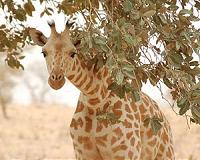| . |  |
. |
Westminster CO (SPX) Aug 17, 2010 In 2003, a massive heat wave struck and killed some 30,000 people in Europe in an area where heat was not considered a major threat. Similar mass die-offs occur in wild birds and some mammals during heat waves, but unlike humans, birds may not be able to take shelter or find fresh water in order to survive devastating heat. What is the outlook for desert bird communities in light of expected global temperature increases on Earth? Blair Wolf, an associate professor of biology at the University of New Mexico, and his collaborator Andrew McKechnie from the University of Pretoria, South Africa, have been studying how increasing global temperatures will impact desert bird populations. They have found that during heat waves, increases in air temperatures of as little as two degrees Fahrenheit can double the rate of water loss in a small bird and importantly impact its survival time.
Predicting Who Will Be the Victims This is due, in part to the fact, that when environmental temperatures are above air temperature, birds and other animals have to get rid of body and environmental heat by evaporating water across the skin and by panting. Evaporative water loss increases rapidly with increasing temperature and excessive water loss reduces a birds' ability to stay cool. The resulting high body temperatures can produce heat stroke, which causes damage to body tissues, organ failure and blood clotting that quickly lead to death. Wolf and McKechnie examined the effects of increased global temperatures and more intense heat waves on the water budgets of desert birds of differing sizes. They used a mathematical model to predict the future water costs for birds living during heat waves in the 2080s compared to the current costs for two hot desert regions, Yuma, Arizona USA and Birdsville, Australia. Their research shows that during heat waves in the 2080s, small birds will show greater increases in water loss rates than larger birds leading to greatly reduced survival times in small birds. For small birds, survival times may be reduced by as much as 30-40%. For all species of birds under 100 grams (the average American Robin weighs about 77 grams) the increase rate in water loss may decrease their survival time by 25%. These observed increases in water loss with more intense heat waves have another potential consequence, for many species, the heat may simply be overwhelming and they may not be able to keep their body temperature below lethal levels. "This is what appears to be happening almost routinely in Western Australia and India now" say's Wolf. The key observations that drive these conclusions are that (1) water is very scarce in deserts; (2) birds that become inactive when it is very hot (i.e., they find a shady place to sit and stay there); and (3) the heat waves cover large areas so the birds can't simply fly away. "Our models allow for making somewhat educated guesses at this point, but real data on bird tolerances to heat and water stress are lacking," says Wolf. The current models and data apply to birds in deserts or climates that are already hot and dry.
Monitoring the Massive Die-Offs "We don't have good research on these die-offs," says Wolf. "No researchers have actually been present during these incidents and no one has actually done the autopsies- so we don't even know the exact cause of death of these animals- whether it was dehydration or heat-stroke." Local knowledge suggests that die-offs can result in the loss of some species from regions for decades and the long-term effects these die-offs have on other groups of plants and animals are as yet unknown. So far, the die-off phenomenon has not been observed in North America. But Wolf predicts the first likely place it could occur in the U.S. would be in the American Southwest, a region filled with a large and diverse bird populations and heat. "These incidents illustrate a need for more basic research on how animals function so that predictions can be made and measures can be taken to preserve our biodiversity," says Wolf.
Share This Article With Planet Earth
Related Links American Physiological Society Darwin Today At TerraDaily.com
 Niger poachers target rare West African Giraffe
Niger poachers target rare West African GiraffeNiamey (AFP) Aug 16, 2010 Poachers in Niger killed two baby West African Giraffes, the first attack on the endangered species in the country for 20 years, an environment official said on Monday. "In less than a month, we have recorded two giraffe deaths linked to poaching," Colonel Malam Issa, who heads Niger's environment and wildlife efforts, told AFP. One of the giraffes had its foot "completely broken" after ... read more |
|
| The content herein, unless otherwise known to be public domain, are Copyright 1995-2010 - SpaceDaily. AFP and UPI Wire Stories are copyright Agence France-Presse and United Press International. ESA Portal Reports are copyright European Space Agency. All NASA sourced material is public domain. Additional copyrights may apply in whole or part to other bona fide parties. Advertising does not imply endorsement,agreement or approval of any opinions, statements or information provided by SpaceDaily on any Web page published or hosted by SpaceDaily. Privacy Statement |